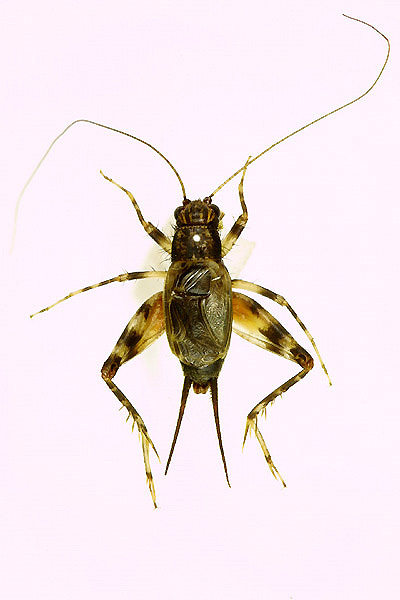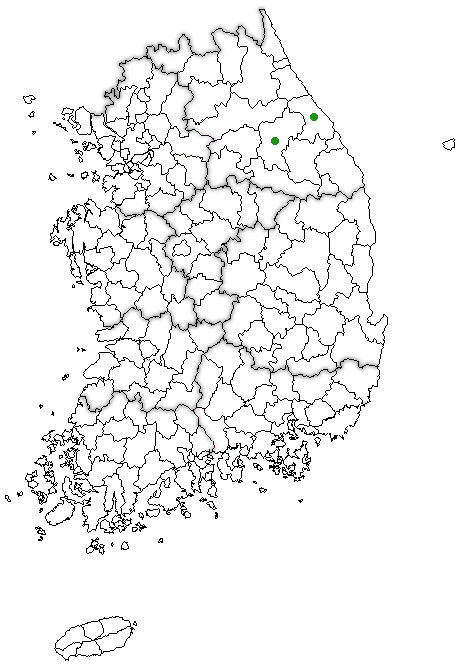여울알락방울벌레
Dianemobius furumagiensis (Ohmachi and Furukawa 1929)
몸길이는 약 8-11 ㎜이며 알락방울벌레와 비슷하나 약간 더 크고 넓적하다. 후퇴절 외측에 3 줄의 뚜렷한 흑백무늬가 있고 작은턱수염 끝은 희다. 암컷의 앞날개 기부는 뚜렷하게 흰 빛을 띤다. 산지 길가의 돌이나 바위 틈, 계곡의 물이 마른 자갈 밑에서 발견된다. 석회암 지대에서 주로 나타난다. 일본, 중국, 대만에도 분포한다.

수컷
(Male)
Original description:
Nemobius furumagiensis
Ohmachi and Furukawa 1929 Proc. Imp. Acad. 5: 374.
General
appearance brownish black or almost black; it has almost the same
pattern as nigrofasciatus.
Body slender and of medium size for the genus, having characteristics
of N. bicolor group. Head small, narrower than the pronotum, with
four pale stripes. Compound eyes ovoidal and projecting. Antennae
brown, slender, about twice as long as the body. Scape large, black
together with the last two segment of maxillary palpi with blunt
angle. The last two segments of the same and the last one of labial
palpi white. Clypeus narrow; frontclypeal suture straight. Antacoria
narrow. Thorax. Pronotum trapeziform broadened towards the posterior
end (a special character in Nemobius),
with long hairs. Lateral lobe almost as deep as long. Meso- and
metasternum broad. Wings. Elytra ♂ shorter than the abdomen, over
one third of caudal femora, basal side white; antero-external angle
protruded; venation peculiar. Diagonal vein wavy, meeting with oblique
vein at a pont. Tympanum large, long; postero-external cell narrow.
Axillary vein bifurcate; apical area narrow. Anal vein at right
angles to the longitudinal axis of the body. ♀ far shorter than
the abdomen, posterior end truncate, basal half white; veins all
very simple, subparallel. Alae in ♂ absent, in ♀ present or absent,
if present, twice as long as elytra. Legs slender and with hairs.
Cephalic legs: tympanum long, elliptical; basal half and a spot
at tips of femur white; tips of tibiae white; tarsi brown and white.
Middle legs: colored as the cephalic legs. Coxa and trochanter of
both legs white. Caudal legs: femur swollen, but under margin nearly
straight, white with three black patches, one situated at the distal
end. (In some specimens the lower two patches are united). Tibiae;
a white spot at distal and proximal ends; spine formula: ♂ E 3.1.II/
I 4.0.II., ♀ E 3.1.II/ I 3.0.II. Tarsi; first segment longer than
the second and the third together, brown and white; tarsal spine
very variable in length. Abdomen. Supre-anal plate paraboidal. Subgenital
plate trapeziform. Cerci long, furnished with hairs, with a pale
marking slightly below the middle. Ovipositor short, lanceolate;
upper margin of the apex furnished with about ten fine denticles.
Measurements.
|
length of body |
8.0-8.2 ㎜ |
8.2-9.0 ㎜ |
|
length of antenna |
13.5 ㎜ |
13.5-15.9 ㎜ |
|
length of pronotum |
1.3-1.7 ㎜ |
1.5-1.9 ㎜ |
|
length of elytron |
4.0-4.6 ㎜ |
2.8-3.6 ㎜ |
|
length of caudal femur |
4.8-5.3 ㎜ |
4.9-5.6 ㎜ |
|
length of cercus |
3.8-4.4 ㎜ |
3.8-4.7 ㎜ |
|
length of ovipositor |
|
3.2-3.8 ㎜ |
Types.
Holotype, ♂ in alcohol; Allotype, ♀ in alcohol with ♂♂ and ♀♀
paratypes in alcohol and dry. All were collected at Furumagi by
the senior author, but some specimens were obtained from the eggs
hatched by him. (Holotype and allotype with a few paratypes in collection
Furukawa's, the other paratypes in Ohmachi's.)
Habitat
and Habits. It is interesting to note that this new species lives
only under pebbles on the railroad track, as far as we are aware.
The senior author noticed a peculiar chirp at the Furumagi Railway
Station, Aomori Prefecture, in August 1926, and there he collected
them in the same month of 1927 and of 1928. He heard them sing at
other stations in northern Japan and near Tokyo.
The
song of this species is high pitched and shrill, totally different
from other members of the genus, which utter monotonous ze∼∼∼ze∼∼∼all
alike. On this respect, nigrofasciatus
is distinguishable from the present species, though they resemble
each other in coloration. N. flavoantennalis
has also a beautiful music for the genus which reminds one of the
noted song of Paratrigonidium bifasciatus
of the subfamily Trigonidiinae. Particularly noteworthy is it that
both flavoantennalis
and the present species seem to belong to the bicolor group.
Comparison.
N. nigrofasciatus
resembles the present species in coloration and in the number of
spines on the caudal femur. In all other details, they are divergent.
N. kimurae of
Formosa seems to have more resemblance (its females has not been
described, so that it is very difficult to make complete comparisons),
but differences are observed in those points of kimurae:
body smaller, only 5.5 ㎜ in length; head wide and short; compound
eyes not so much protruded; antenna shorter, only as long as the
body; pronotum rectangular; lateral lobe longer than wide; male
tegmen reaches the end of the body, basal side not white, its venation
is different; only two black markings on the caudal femur; 4:4 (or
3:4) spines on the caudal tibia. From the above differential characters
the present species, Nemobius furumagiensis,
seems to be a good species new to science.

<참고문헌>